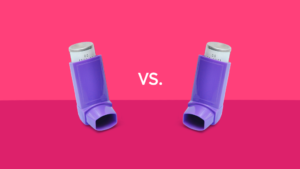The Difference Between Diabetic Coma and Insulin Shock
HOME | DIABETES EDUCATION | THE DIFFERENCE BETWEEN DIABETIC COMA VS INSULIN SHOCK
When dealing with diabetes complications, it’s crucial to differentiate between diabetic coma and insulin shock.
These conditions stem from glucose imbalances and have distinct symptoms and consequences that require quick identification and specific treatment.
Understanding the differences between diabetic coma and insulin shock is essential for effectively managing these critical situations.
By knowing these distinctions, individuals can better equip themselves to handle diabetes-related emergencies.
Key Takeaways; Difference Between Diabetic Coma vs Insulin Shock
- Diabetic coma results from high blood sugar levels, while insulin shock stems from low blood sugar levels.
- Diabetic coma symptoms include dehydration and fruity breath odor, while insulin shock causes confusion and rapid heartbeat.
- Diabetic coma requires intravenous insulin therapy, while insulin shock is treated with fast-acting carbohydrates or glucagon injection.
- Prevention strategies involve monitoring glucose levels and educating about warning signs for both conditions.
Understanding Diabetic Coma
A diabetic coma is a serious medical emergency that can occur in individuals unaware of their diabetic condition, marked by a gradual onset of elevated blood sugar levels over days or weeks. Symptoms include frequent urination, thirst, shallow breathing, vomiting, and tiredness.
If untreated, it can progress to loss of consciousness and dehydration. Recognizing these signs and seeking immediate medical attention is crucial in managing diabetic coma effectively.
The condition originated in the 19th century when accurate blood sugar measurement methods were limited, highlighting the importance of modern diagnostic tools. Understanding the symptoms and risk factors associated with diabetic coma is essential for individuals, healthcare providers, and caregivers to ensure timely intervention and prevent severe outcomes.
Exploring Insulin Shock
Insulin shock triggers the body’s fight or flight response due to decreased glucose levels, leading to symptoms like confusion, rapid heartbeat, sweating, and weakness. Prompt treatment involves consuming sugar or glucose to raise blood sugar levels.
Monitoring blood glucose levels, following a balanced diet, and carrying fast-acting sugar sources are crucial preventive measures. Insulin shock can affect both diabetics and non-diabetics, emphasizing the importance of managing low blood sugar levels to prevent complications like dehydration or high blood sugar levels.
Causes of Diabetic Coma; Type 1 Diabetes, People With Diabetes
Causes of Diabetic Coma:
- Missed Insulin Doses
- Infections
- Illness
- Excessive Carbohydrate Intake
Causes of Insulin Shock; Hypoglycemia, Type 2 Diabetes
Insulin shock, also known as hypoglycemia, occurs when blood sugar levels drop too low, leading to various symptoms like confusion, rapid heartbeat, sweating, and weakness. The main causes of insulin shock are excessive insulin dosage, increased physical activity, and missed meals or changes in eating habits.
Recognizing early signs of hypoglycemia is crucial to manage insulin shock effectively. Immediate treatment with sugar or glucose can help restore blood glucose levels and prevent serious complications.
Regular monitoring of blood sugar levels and understanding warning signs of hypoglycemia are essential in preventing episodes of insulin shock.
Symptoms of Diabetic Coma; Warning Signs, Hyperglycemia
Diabetic coma symptoms include shallow breathing, persistent vomiting, extreme tiredness, and fruity breath odour. Early signs such as frequent urination and constant thirst can also indicate diabetic coma.
Hypoglycaemia, or low blood glucose levels (below 3.5 mmol/l), may occur if a person on insulin or certain other diabetes medications (such as sulphonylureas tablets): takes an extra dose or an increased dose. exercises strenuously without eating extra food or reducing their medication.
https://www.betterhealth.vic.gov.au/health/conditionsandtreatments/diabetic-coma
Prompt recognition of these signs is crucial to prevent complications. Seek immediate medical help if experiencing these symptoms to avoid diabetic coma progression. Vigilance towards warning signs helps manage this serious condition effectively.
Signs of Insulin Shock or Diabetic Shock
Symptoms of insulin shock include confusion, rapid heartbeat, and sweating, while signs of diabetic shock encompass fruity breath odour, rapid breathing, and an increased risk of seizures if left untreated.
Additional symptoms of insulin shock may involve trembling, hunger, dizziness, and sweating, whereas diabetic coma symptoms may include dehydration, unconsciousness, and shallow breathing. Prompt recognition of these distinct symptoms is crucial for immediate medical intervention to prevent complications related to low blood sugar levels or untreated diabetes.
Diagnosing Diabetic Coma and Insulin Shock
Diagnosis of diabetic coma involves identifying symptoms like fruity breath odour, rapid breathing, and seizures. Insulin shock presents with confusion, sweating, trembling, dizziness, and hunger. Factors, like missed insulin doses, illness, or infection, are common in diagnosing diabetic coma.
In contrast, excessive insulin intake, physical activity, or changes in insulin dosages are typical in insulin shock diagnosis. Prompt medical attention is crucial for accurate diagnosis and management to prevent complications. Recognizing these symptoms promptly can lead to timely intervention and improved outcomes for individuals experiencing diabetic coma or insulin shock.
Treatment for Insulin Shock vs Diabetic Coma
Prompt and appropriate treatment is crucial for managing insulin shock and diabetic coma due to their critical differences in blood sugar levels.
- Insulin Shock Treatment:
- Administer fast-acting carbohydrates like glucose gel or tablets to raise blood sugar levels quickly.
- Consider a glucagon injection in severe cases for a rapid blood sugar increase.
- Diabetic Coma Treatment:
- Focus on restoring blood sugar levels with intravenous insulin therapy to lower high blood sugar levels.
- Hospitalization may be necessary for close monitoring and addressing complications effectively.
- Importance of Prompt Medical Attention:
- Timely intervention and appropriate treatments are essential to prevent serious complications and ensure recovery from insulin shock and diabetic coma.
Prevention of Diabetic Coma
Preventative measures against diabetic coma include monitoring blood glucose levels and following a balanced diet. Identifying early signs like extreme thirst, frequent urination, fatigue, and blurred vision is crucial.
Seeking prompt medical attention for concerning symptoms is essential. Educating about risks and warning signs is vital. Maintaining a healthy lifestyle, managing stress, and staying hydrated can help prevent diabetic coma.
Preventing Insulin Shock
To prevent insulin shock, early recognition of hypoglycemia symptoms is crucial. Strategies to prevent insulin shock include:
Balanced Diet: Consuming a diet rich in complex carbohydrates, proteins, and healthy fats helps stabilize blood sugar levels.
Blood Sugar Monitoring: Regularly monitoring blood sugar levels, especially before and after meals, physical activity, and bedtime, is essential.
Fast-Acting Sugar Sources: Carrying glucose tablets or juice can swiftly address low blood sugar episodes.
Frequently Asked Questions
What Is the Difference Between a Diabetic Coma and Insulin Shock?
Diabetic coma and insulin shock differ in causes, symptoms, and outcomes. Diabetic coma results from high blood sugar levels, leading to unconsciousness, while insulin shock stems from low blood sugar levels, causing confusion and weakness. Prompt medical attention is crucial for both conditions.
What Is Another Name for a Diabetic Coma?
Hyperosmolar hyperglycemic state (HHS) is another term for a diabetic coma. Extremely high blood sugar levels mark this condition and require immediate medical attention to prevent severe complications and organ damage.
What Happens During Insulin Shock?
Insulin shock causes symptoms like confusion, rapid heartbeat, sweating, and weakness due to low blood sugar levels. Immediate intervention with sugar or glucose is crucial to raise blood sugar levels and prevent complications. Recognizing early signs and seeking prompt medical attention are essential.
What Is the Best Rule to Follow in Doubt Diabetic Coma and Insulin Shock?
When unsure between diabetic coma and insulin shock, prioritize immediate medical attention for accurate diagnosis and treatment. Symptoms like confusion and rapid heartbeat indicate insulin shock, while fruity breath odour and rapid breathing point to diabetic coma. Understanding the causes helps differentiate between the two conditions.



